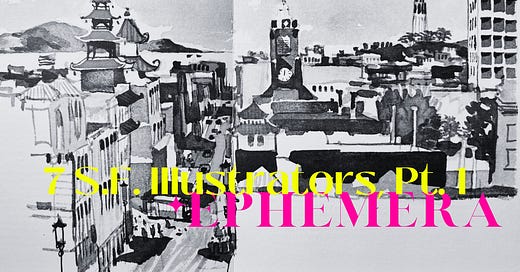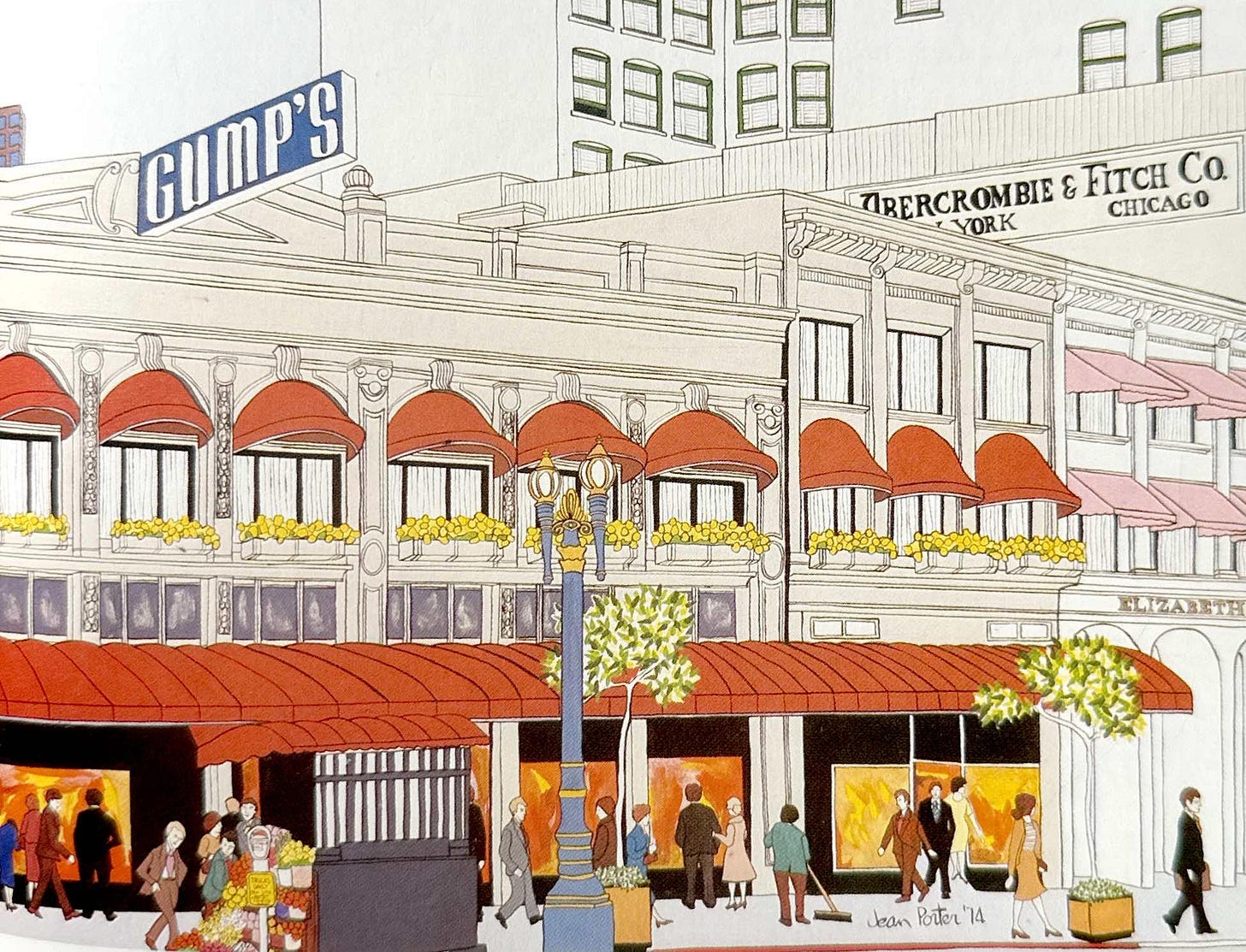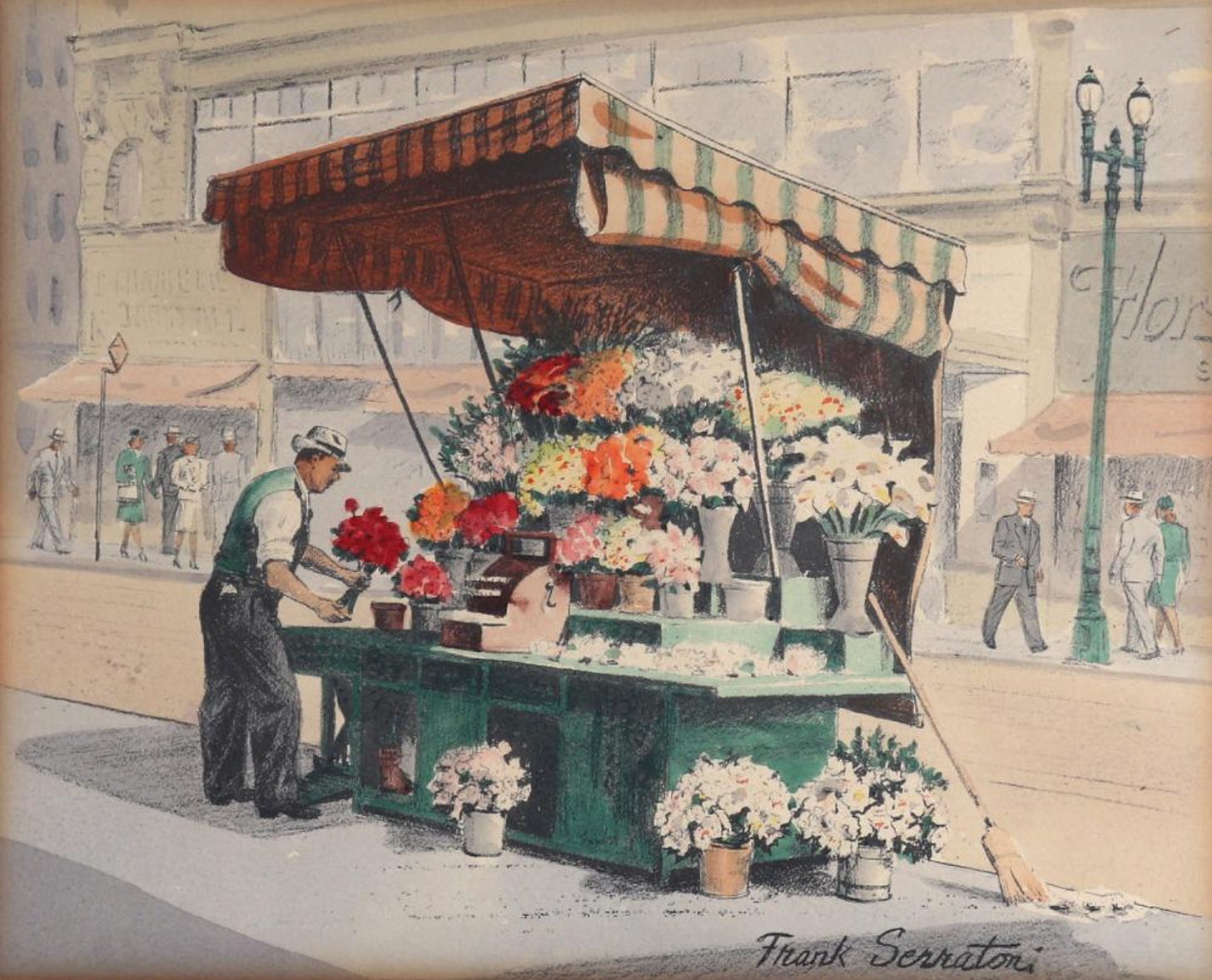FYI: You may need to click through from email to read in full!
Unless cited otherwise, images in this post have been scanned by the author from books in my collection:
San Francisco The Cool Gray City of Love by Jean Porter and Leonard Cahn
San Francisco City on Golden Hills by Herb Caen and Dong Kingman
Etchings of San Francisco Through the Years by Alec Stern
Cable Car Days in San Francisco by Edgar M Kahn with William Wilke
Images by Frank Serratoni were found online at art auction sites.
Images by Paul Madonna were found online at the artist’s website or The Nob Hill Gazette.
Images by Michele Bell were found online at the artist’s website.
I’ve had this post in mind for so many weeks now and it’s been building and building. I *think* it came to me this last summer when my friend Meg and I went thrifting and I found an incredible book: San Francisco The Cool, Gray City of Love by with paintings by Jean Porter and text by Leonard Cahn. I’d never seen it before, but I recognized a very specific image of Gump’s on Post Street from 1974. I believe the image was used by Gump’s for marketing postcards and sale announcements for years, because I have a very strong memory of my mother having it posted to her kitchen bulletin board forever. The book was priced at $10, but I got it for $5 and felt like I’d scored big time.
Turns out, I wasn’t wrong. The Porter-Cahn book is long out of print making it especially coveted by San Franciscans and art lovers alike. Currently there are a few copies on AbeBooks ranging between $17 & $132.
I nestled my precious copy of Jean Porter’s paintings next to another precious book of San Francisco illustrations and words that is also out of print: San Francisco: City on Golden Hills by Herb Caen and Dong Kingman. I found a copy of this book years ago either at Russian Hill Bookstore on Polk Street or Nest on Fillmore Street. Both shops have an amazing selection of old San Francisco books. Then, wouldn’t you know it…I found I already had a copy in my storage space in a box of San Francisco books my Mom had collected over the years. Weeks later I also found Etchings of San Francisco Through the Years by Alec Stern among my Mom’s (more likely my Grandpa’s) books, and then a few weeks after (and back at Nest) I nabbed a copy of Cable Car Days in San Francisco by Edgar Kahn with illustrations by William H. Wilke, whom I’d already been researching.
Earlier this year I read Paul Madonna’s latest novel, The Commissions, which also includes a generous array of his stunning illustrations of the city. So, I suppose something about the illustrations — and illustrators — has been milling in my brain for a while now. I felt like all these signs were pointing me to this post.
So what is it about illustrators and how they depict San Francisco? Why illustration over photography, say? Well, like photography illustration depicts a specific time, chronicling a place at a certain moment that in another day, week, year may be completely different. Illustration, no matter how formal or communicative, also imparts the artist’s hand and style in a distinct way. So, even as the illustrators I talk about here have depicted some of the same views of San Francisco, they all put their own sense of space, form, and expression into the mix, bringing the city to vibrant life. They also often illustrate moments that would generally be considered unworthy or not special enough for an art piece, but as illustration is often quickly made, these locales are never overlooked and give quirky texture to the landscape.
Confession: I studied art in college at UC Davis and I was pretty darn good at it. Then, I went on to study fashion at FIDM where I had to take a fashion illustration course. I went into the course thinking it would be a piece of cake: I had an art degree, after all. Boy was I WRONG. It turns out that the expression and freedom that can be found in art needs to be constrained in illustration in order to interpret something with accuracy and precision. Illustration became the class that made me struggle quite a bit. Illustration (rendering, interpreting) being more of a commercial endeavor doesn’t necessarily welcome the boundary-pushing and expression of art. You can definitely get there (as you’ll see), but it’s delicately done.
In the early days of print, illustrations were traditionally converted to etchings or lithographs allowing them to be reproduced quickly and cheaply, which also allowed them to be included in novels and newspapers. The Annals of San Francisco from 1855, despite its highly problematic racist and imperialist bias, is still the best account of early San Francisco life. It included 103 total illustrations in its publication (with no artist credited), showing elements of the city from its Gold Rush Days. These small images chronicle a city that is long gone due to destructive fires and endless rebuilding, and apart from certain specific viewpoints, the city is largely unrecognizable.
As cities change, so do its images. The few consistent anchor points over the years allow time to jump while focused on one view. Luckily our city has attracted a wealth of image makers to help chronicle the time leaps.
Standard Substack personal indemnity clause: Although I know there are MANY illustrators of San Francisco, I’m going to focus on this select group mostly because of my own history with them. In fact, you can probably go down to Aquatic Park or Fisherman’s Wharf and find someone amazing who will be only to happy to sell you some prints or lithographs. The talent is there! Apologies in advance if I overlook your favorite, but these are my own. While I could rightly do a full post on each of them, I wanted to focus on how they are often in dialogue with each other, so will be offering minimal biographies in order to showcase the work.
William Hancock Wilke
William Hancock Wilke (1879 - 1958), a painter, printmaker, designer and illustrator, Wilke was born in San Francisco in 1879. He studied at the Mark Hopkins Art Institute1 and later the Académie Julian in Paris. He returned to San Francisco in 1905, and went to work for Shreve & Co as a gold and silver designer for over 30 years.

Wilkie’s precision and cross-hatch style definitely translates to the skilled hand of a jewelry/metalwork designer and engraver. Later on, he used this talent to create precise renderings of old San Francisco from photographs, as did this next artist…
Alexander Stern
Alexander “Alec” Stern (1904 - 1994) was born in Connecticut but moved to San Francisco while very young where his family settled in Cow Hollow. He attended Polytechnic High and later Columbia University. Returning to San Francisco he pursued studies at the California School of Fine Arts.2 He worked his way through school as a riveter in the shipyards, and after selling a number of illustrations to the paper as a freelancer, was hired on-staff at the San Francisco Chronicle.
My Grandma had prints by Alec Stern framed in her house and they looked so foreign to me as a kid, I didn’t realize they depicted a part of my own city.
Crazy Old Daisy Telegraph Hill and Shingled Houses, Telegraph Hill by Alec Stern hung side-by-side showing a bygone era of the bohemian shacks that hung precariously from the hillside. The first one even shows the turrets of the original Julius’ Castle that used to stand there. When I found the book of Stern’s etchings, I was so happy to see these two again.
Apart from my own knowledge of these images, I looked up Alexander Stern in the SF Chronicle archives and found that his beat was the “Shipping News” — a full-page of the comings and goings of the port of San Francisco — to which he contributed a detailed illustration every Sunday for years. While the port activity is much less prevalent now than it was 90-100 years ago, during the early days of the Depression, labor was given prominence. In 1934, while Stern was illustrating the page, the West Coast waterfront strike was a huge headline across America as longshoreman struck, which eventually led to a general labor strike in San Francisco for four days. Stern and “Shipping News” columnist Jack Densham give a sympathetic tone to the workers in the port, with Stern crafting romantic, wistful images and Densham an accompanying poem nearly every weekend.
Stern would go on to do etchings for holiday and greeting cards which were popular purchases from both Stern’s studio and retailers around the city. I believe it is from Stern’s studio that someone in my family purchased his book of etchings.
Frank Serratoni
Yet another artist I know from the framed lithographs that once hung in my Grandma’s house, Frank Serratoni (1906 - 1970) is truly a San Francisco treat. Exotic Chinese buildings, heavy ferry boats, fat cable cars — all interpreted in vibrant colors and smooth strokes. We had a set of five of his prints from my Grandma’s and at one point I had them remounted and re-matted; the framer said the vintage frames were perfect for the pieces, but the cardboard backings were NOT acid-free after 50-odd years, so they had to go. My Granny said they had once hung in my Grandpa’s law firm, so when my sister graduated from law school I gave them to her as a present.
Serratoni’s lithographs are like happy little idyllic cartoons of the everyday life of the city.
Originally from Detroit, MI, Serratoni studied at the Detroit Society for Arts & Crafts. Moving to Chicago, he attended classes at the Chicago Art Institute and then moved to San Francisco in the early 1940s. His lithographs of the city became his bread-and-butter, selling to tourists and locals alike. The scenes were lithographed in black and white, and Serratoni would then hand-watercolor the image, which made them look like an original piece. Serratoni sold in Paul Elder’s Book Store and City of Paris. His pieces still hang in the Fairmont Hotel and the Olympic Club.
Dong Kingman
A world-reknown watercolor master and pioneer of the “California Style” school of painting, Dong Kingman (born Jingwen Zeng, 1911 - 2000) is likely the most famous of all San Francisco illustrators. Apart from the book he did with Herb Caen in 1967 (which is amazing and also out of print, but can be found on AbeBooks from $20 - $70) , I was pleased to discover that one of my vintage Holiday Magazines that I have framed on my wall also features a cover illustration by Dong Kingman. (The article inside sadly does not feature more of Kingman’s work, but is a mix of photography and a smattering of whimsical illustrations by none other than José Bartolí…The original Holiday was an incredible pub.) Kingman also famously illustrated the title cards to the Universal-International film of the Rodgers and Hammerstein musical The Flower Drum Song in 1961. (To be honest, it isn’t the best, but it’s cute and is set in San Francisco even if it was mostly filmed on a sound stage. The “Grant Avenue” number is a lot of fun.)
Incredibly prolific and accomplished, I could devote an entire post to Dong Kingman, but for this post I will need to provide a short version.
Kingman was born in Oakland to Chinese parents, but the family returned to Hong Kong within a few years. As a boy he studied art, learning traditional Chinese watercolor techniques before returning to America when he was 18 years old. By the mid-1930s, Kingman was considered one of the leaders of the California watercolor movement, with the SFMOMA acquiring some of his pieces for their collections. A Guggenheim fellowship sent him traveling around the United States where he spent time in New York and began creating cityscapes. Later on, Kingman taught at RISD, Columbia University, and Hunter College, among others.
Jean Porter
After finding the book of Jean Porter’s illustrations, I tried to learn more about her…and there isn’t a lot. On the dust cover a brief biography provides only a few solid clues: that she was born in California and that she was the first manager of the Palace of Fine Arts Theatre. Apparently painting and illustration was a personal passion after being involved in the theatre world, but apart from her book, any other works are in the wind. I’ve tried searching her name and since it’s fairly common, it leads to other Jean Porters who are also artists, but not this Jean Porter. I found a brief quote she once gave to the SF Chronicle about a show at the Palace of Fine Arts Theatre, but otherwise there’s nothing I can find.
As mysterious as she sounds, her images of San Francisco are the opposite. They’re bright and lively and almost childlike with their enthusiastic takes on the city. The more I look, the more I see hints of 19th century Japanese prints or Post-Impressionism in Porter’s style and spacing; fields of color are left flat, while flora is given a dabbed treatment similar to Van Gogh. Her images are fun and playful, almost corny, but I like a little corn.
Paul Madonna
Like most locals, I believe I first saw Paul Madonna’s work in his weekly strip All Over Coffee…followed closely by his work with Gary Kamiya on the book Spirits of San Francisco - Voyages Through the Unknown City. The two occasionally (actually I’m not sure if this is current or not, but I hope it is…) still collaborate on pieces for The Nob Hill Gazette.
I love his takes on the modern city. His views feel calm, quiet, and definitely emptied-out; maybe this is an idealistic take, or maybe he just strips away the people and noise so we can see the view in a new way. Things are perfectly detailed, but also slightly warped in a subtle way — just as the way we see things.
Michele Bell
Artist and creative Michele Bell works in both illustration and photography, but is perhaps best-known for her charming renderings of popular San Francisco restaurants. Her style is simple and whimsical, inspiring excitement about where to go and what to do around the city. Nothing moves faster in a city than restaurant or retail locales (which is why illustration is such a fleeting delight), and Bell captures both beautifully, alongside more classical renderings of prominent architecture and landmarks.
Stay tuned for Part 2 where I dig into the many views of San Francisco all of these artists explore, celebrating their contrasting interpretations in time.
Books
Caen, Herb & Dong Kingman, San Francisco City on Golden Hills, Doubleday & Company, Inc. Garden City, NY, 1967
Kahn, Edgar M. (with William H. Wilke), Cable Car Days in San Francisco, Stanford University Press, Stanford University California, 1940
Kamiya, Gary & Paul Madonna, Spirits of San Francisco: Voyages Through the Unknown City, 2020, Bloomsbury Publishing,
Porter, Jean & Leonard Cahn, San Francisco The Cool, Gray City of Love, E.P. Dutton, New York, 1981
Stern, Alec, Etchings of San Francisco Through the Years, Studio of Alec Stern, 1965
In 1871, a small group of artists, writers, and community leaders formed the San Francisco Art Association. The sought to promote regional art and artists and preserve the new and distinct art of the American West. By 1874 they had 700 members and enough funds to launch a school named the California School of Design. After Mark Hopkins’ death in 1878, his wife Mary remarried Edward Searles, the architect of the mansion on Nob Hill. After Mary’s death in 1891, Searles donated the opulent Hopkins Mansion to the University of California, in trust for the SFAA for "instruction in and illustration of the fine arts, music and literature." The school was then renamed the Mark Hopkins Art Institute.
The Mark Hopkins mansion and all it held (including early California paintings, art, archives, records, and the entirety of the SFAA and its facilities) went up in flames during the 1906 earthquake. Although the damage was estimated at $2.5 million, the school received only $100,000 from its various insurance policies. Undaunted, the SFAA rebuilt in the same location for another 10 years before merging with the San Francisco Society of Artists in 1916. At this point, the school was renamed the California School of Fine Arts. In 1926 the school moved to a new location at 800 Chestnut Street, and the original location became the site of the Mark Hopkins Hotel. The school became a prominent incubator for art on the West Coast, especially the areas of photography, Abstract Expressionism, and Bay Area Figurative art. In 1961, the school became the San Francisco Art Institute. Tragically, the school closed permanently in 2022.















